Maintaining a swimming pool ensures safety, hygiene, and clarity. Regular tasks include balancing chemicals, cleaning debris, and equipment care to prevent issues and extend pool lifespan.
1.1 Importance of Regular Pool Maintenance
Regular pool maintenance is crucial for ensuring safety, hygiene, and water clarity. It prevents algae growth, bacterial contamination, and equipment damage. Neglecting maintenance can lead to cloudy water, harmful chemicals, and costly repairs. Proper upkeep also extends the lifespan of pool equipment and enhances the swimming experience. Consistent care ensures a clean, safe, and enjoyable environment for users, making it essential for both residential and public pools. Regular maintenance also helps in maintaining the aesthetic appeal of the pool area.
1.2 Overview of Pool Maintenance Tasks
Pool maintenance involves monitoring water hygiene, lighting, pumps, filters, and safety equipment. Regular tasks include balancing chemicals, cleaning debris, and ensuring proper sanitation. Monitoring real-time data and controlling equipment remotely can enhance efficiency. Seasonal tasks like opening and closing the pool are essential for longevity. Proper maintenance prevents issues like algae growth and cloudy water, ensuring a safe and enjoyable swimming environment. Following a structured maintenance schedule helps maintain the pool’s aesthetic appeal and functionality throughout the year.

Types of Swimming Pools and Their Maintenance Needs
Swimming pools vary by type, including public, semipublic, and residential, each requiring tailored maintenance to ensure safety, hygiene, and functionality based on usage and design.
2.1 Public Pools
Public pools require rigorous maintenance due to high usage. Regular water testing ensures chemical balance, while filtration systems must operate efficiently to maintain clarity and safety. Daily cleaning of surfaces and surrounding areas is essential to prevent contamination. Equipment inspection, including pumps and filters, is crucial to uphold hygiene standards. Public pools must adhere to strict health guidelines to ensure a safe environment for all users, making consistent upkeep a top priority to avoid closures and maintain user trust.
2.2 Semipublic Pools
Semipublic pools, such as those in hotels, condominiums, or schools, serve specific groups. Maintenance focuses on balancing heavy use with aesthetic appeal. Regular water testing and chemical adjustments are crucial to prevent contamination. Filtration systems must run efficiently to maintain clarity. Cleaning schedules should be frequent to handle multiple users. Safety standards are less stringent than public pools but still require attention to hygiene and equipment function. Proper upkeep ensures a clean, safe environment for consistent enjoyment by the intended user group.
2.3 Residential Pools
Residential pools are private, typically smaller, and designed for family or personal use. Maintenance focuses on preserving water quality and extending equipment lifespan. Daily tasks include skimming debris and monitoring water levels. Weekly routines involve testing chemical balances and cleaning filters. Monthly checks should inspect equipment for wear and tear. Seasonal servicing, like heater maintenance, ensures year-round functionality. Regular upkeep keeps the pool safe, hygienic, and visually appealing for continuous enjoyment by homeowners and their guests.
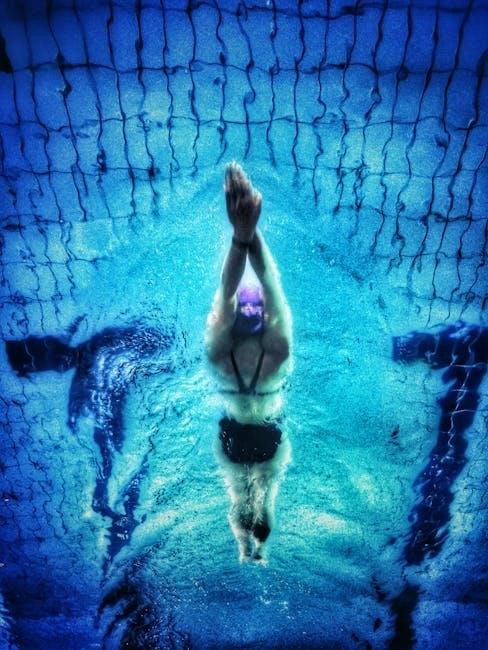
Regular Maintenance Tasks
Regular pool maintenance is essential for safety, hygiene, and equipment efficiency. It involves daily, weekly, and monthly tasks to ensure clean water and system longevity.
3.1 Daily Maintenance
Daily maintenance ensures your pool remains clean and safe. Skim debris from the surface, check chemical levels, and monitor equipment operation. Rinse filters if necessary and clean the surrounding area to prevent contamination. Regular visual inspections help identify issues early, maintaining water clarity and hygiene. Consistent effort prevents algae growth and keeps the pool system running smoothly throughout the season.
3.2 Weekly Maintenance
Weekly maintenance involves deeper cleaning and checks to ensure optimal pool performance. Clean the pool floor and walls using a vacuum and brush. Shock the pool to eliminate contaminants and maintain clarity. Check and clean filters, ensuring proper water circulation. Inspect the pump, heater, and surrounding equipment for functionality. Test and adjust chemical levels as needed. Regularly inspect the pool surround and decking for damage or wear. Consistent weekly maintenance prevents issues and extends equipment lifespan. Properly document all tasks for future reference.
3.3 Monthly Maintenance
Monthly maintenance ensures long-term pool health and prevents major issues. Deep clean the filters by backwashing or replacing them as needed. Check and adjust the pool’s pH and alkalinity levels thoroughly. Inspect and lubricate equipment like O-rings and pumps. Clean the strainer baskets and inspect the pool liner or tiles for damage. Check salt or chlorine levels and adjust accordingly. Perform a thorough inspection of all equipment and connections to prevent leaks or malfunctions. This routine helps maintain water quality and equipment efficiency year-round.

Water Chemistry and Treatment
Proper water chemistry and treatment are crucial for maintaining a safe and clean pool environment. Balancing pH, sanitizers, and stabilizers prevents algae growth and equipment corrosion.
4.1 Testing Pool Water
Regular testing of pool water is essential to ensure safety and clarity. Check pH levels, chlorine content, and alkalinity weekly. Use test strips or a digital tester for accuracy. Maintain pH between 7.2 and 7.8 to prevent eye irritation and equipment damage. Chlorine levels should be 1-3 ppm for effective sanitization. Test stabilizer levels monthly to protect chlorine from sunlight degradation. Adjust chemicals as needed to maintain balanced water chemistry. Consistent testing prevents algae growth and keeps the water safe for swimmers. Always follow manufacturer instructions for testing kits.
4.2 Balancing Chemical Levels
Balancing pool chemicals ensures water safety and clarity. Adjust pH, chlorine, and alkalinity levels based on test results. Aim for a pH of 7.2-7.8 and chlorine at 1-3 ppm. Alkalinity should be 80-120 ppm to stabilize pH. Use chemicals like soda ash or muriatic acid for pH adjustments. Add stabilizer (CYA) to protect chlorine from sunlight. Balance chemicals gradually, testing after each adjustment. Proper balancing prevents eye irritation, equipment corrosion, and cloudy water. Always follow safety guidelines when handling pool chemicals.
4.3 Sanitization and Disinfection
Sanitization and disinfection are crucial for maintaining clean and safe pool water. Chlorine, bromine, or saltwater systems are commonly used to kill bacteria and contaminants. Shock treatments should be applied weekly to eliminate chloramines. Always maintain proper stabilizer levels to protect chlorine from sunlight. Regularly clean skimmer baskets and filters to ensure optimal circulation. Proper sanitization prevents infections, reduces odors, and keeps water sparkling. Follow manufacturer guidelines for chemical dosages to ensure effectiveness and safety.
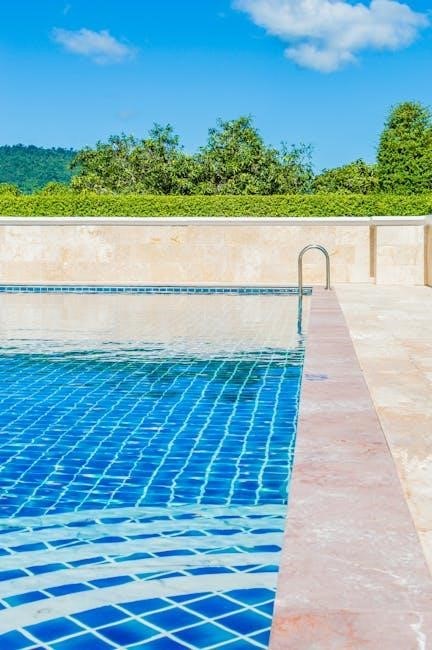
Pool Equipment Maintenance
Regular inspection and maintenance of pumps, filters, heaters, and automation systems ensure optimal performance. Clean and replace filters, check for leaks, and follow manufacturer guidelines for servicing.
5.1 Pumps and Filters
Regular maintenance of pumps and filters is crucial for clean and clear pool water. Ensure pumps operate smoothly and filters are cleaned or backwashed when pressure rises. Replace filter cartridges every 3-5 years to maintain efficiency. Check for leaks and proper flow rates. Daily inspections and prompt repairs prevent equipment failure. Balanced chemical levels also support filtration efficiency. Proper pump and filter maintenance ensures energy savings and extends equipment lifespan, keeping your pool water clean and safe for swimming.
5.2 Heaters and Heat Pumps
Proper maintenance of pool heaters and heat pumps ensures consistent water temperature and energy efficiency. Regularly clean the heater’s exterior and inspect for leaks or damage. Check the thermostat and sensors to ensure accurate temperature control. For heat pumps, maintain proper airflow and clean filters to optimize performance. Schedule annual professional inspections to identify potential issues early. Balanced water chemistry also supports heater efficiency. Regular upkeep extends the lifespan of these systems and ensures reliable pool heating throughout the season.
5.3 Automation Systems
Automation systems streamline pool maintenance by controlling pumps, heaters, and sanitizers. Regularly update software and ensure sensors are clean and free of debris. Test automated functions like timers and remote controls to ensure proper operation. Inspect wiring and connections for damage or corrosion. Maintain proper water flow to prevent system errors. Regular servicing by professionals is recommended to keep automation systems running efficiently and ensure all components work in harmony for optimal pool performance and energy savings.

Safety and Hygiene
Maintaining a clean and safe pool environment is crucial for health and accident prevention. Regular cleaning, proper chemical handling, and ensuring a clean surrounding area are essential practices.
6.1 Safety Equipment
Essential safety equipment includes life jackets, rescue tubes, first aid kits, and emergency phones. These items must be easily accessible and regularly inspected to ensure functionality. Proper storage and maintenance of safety gear are critical to prevent accidents and ensure quick response in emergencies. Always follow manufacturer guidelines for equipment upkeep and replacement. A well-stocked and visible safety station fosters a secure swimming environment, reducing risks and promoting confidence among pool users.
6.2 Hygiene Practices
Proper hygiene practices are vital for maintaining a clean and healthy pool environment. Swimmers should shower before entering the pool to remove dirt and oils. Regularly clean pool surfaces, tiles, and surrounding areas to prevent dirt buildup. Disinfect high-touch areas like ladders and handrails. Empty skimmer baskets frequently to ensure proper filtration. Encourage swimmers to use designated waste bins and avoid bringing glass containers near the pool. Establishing clear hygiene rules helps maintain water quality and reduces contamination risks, ensuring a safer swimming experience for everyone;
6.3 Emergency Procedures
In case of emergencies, having a well-prepared plan is crucial. Ensure all pool users know the location of emergency exits and first aid kits. Post clear instructions for CPR and rescue techniques near the pool. Regularly inspect rescue equipment like life rings and ropes. Train staff or pool owners in emergency response procedures. Keep a phone nearby to quickly call for professional help if needed. Proper preparation can prevent accidents from escalating and ensure timely assistance.
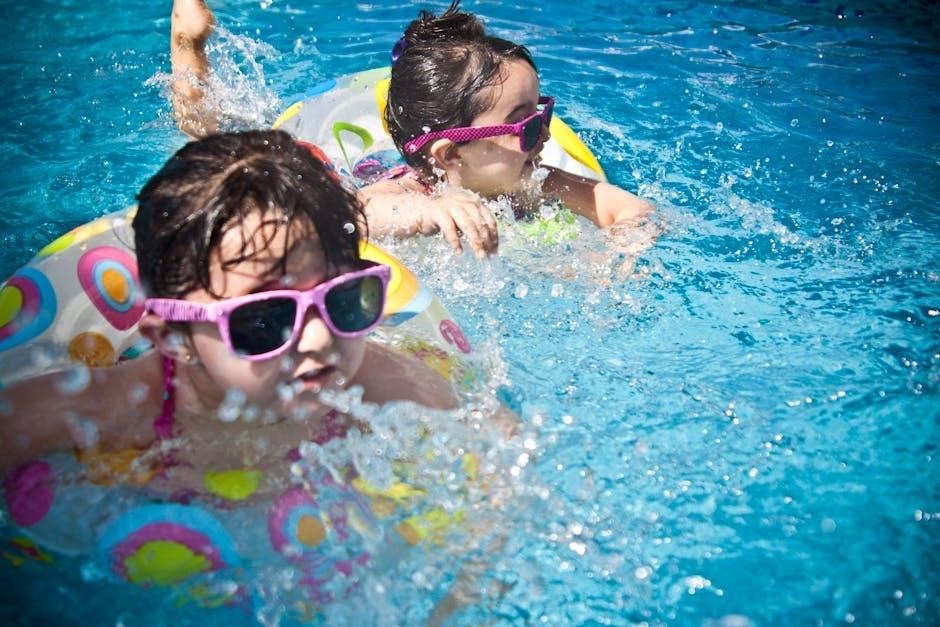
Seasonal Maintenance
Seasonal maintenance ensures your pool remains functional and clean year-round. Adjust routines for summer, winter, and holidays, including equipment preparation and thorough cleaning.
7.1 Opening the Pool for the Season
Opening your pool for the season involves several key steps to ensure it’s clean, safe, and ready for use. Start by removing the pool cover and cleaning it thoroughly. Inspect the pool and surrounding area for debris, and repair any damage. Test the water chemistry and balance the pH, alkalinity, and chlorine levels. Shock the pool if necessary to eliminate contaminants. Reinstall any winter plugs and prime the pump and filter system. Finally, check all safety equipment and ensure everything is functioning properly before use.
7.2 Closing the Pool for Winter
Closing your pool for winter requires careful preparation to protect it from damage. Start by removing debris and testing the water to ensure proper chemical balance. Lower the water level slightly to prevent freezing. Winterize the plumbing and equipment, and install winter plugs. Use a winter cover to shield the pool from contaminants. Apply a winterizing kit to prevent algae and corrosion. Regularly inspect the pool during winter to maintain its condition until reopening.
7.3 Holiday Maintenance Tips
During holidays, increased pool usage can strain the system. Regularly test and adjust chemical levels, especially after heavy use. Clean the pool and surrounding area frequently to prevent debris buildup. Consider using a pool cover when not in use to keep contaminants out. Check equipment function before gatherings to avoid issues. Monitor water levels and perform shock treatments if necessary. These steps ensure your pool remains safe, clean, and enjoyable for everyone during the holiday season.
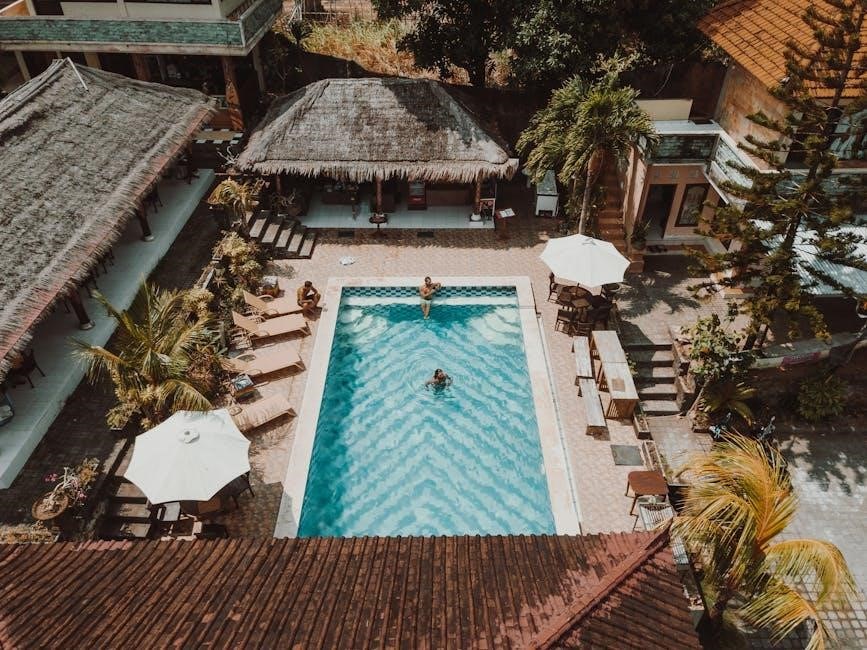
Troubleshooting Common Issues
Identify and resolve common pool problems like cloudy water, algae growth, or equipment malfunctions. Regular inspections and proper maintenance help prevent these issues, ensuring optimal pool performance and safety.
8.1 Cloudy or Discolored Water
Cloudy or discolored water is often due to imbalanced chemical levels, poor filtration, or contamination. Test chlorine, pH, and alkalinity levels to identify the issue. Shock the pool if necessary. Run the filter continuously and ensure proper circulation. Introduce a clarifier to clear the water. Regularly clean the filter and skimmer to remove debris. Addressing these factors promptly prevents further complications and restores water clarity for a safe and enjoyable swimming environment.
8.2 Algae Growth
Algae growth is a common issue caused by poor sanitation, imbalanced chemical levels, or inadequate filtration. Green algae are the most frequent type, appearing as slimy or cloudy patches. To address this, test and balance chlorine and pH levels. Shock the pool if necessary to eliminate contaminants. Brush pool surfaces to remove algae, and run the filter continuously. Introduce an algaecide as a preventative measure. Regular cleaning and proper chemical maintenance are key to preventing future algae growth and maintaining a clean, swimmable pool.
8.3 Equipment Malfunction
Equipment malfunction can disrupt pool operations and safety. Common issues include faulty pumps, clogged filters, or heater failures. Regular inspection of pumps, filters, and heaters is essential to identify worn parts or blockages. Check power supply connections and ensure proper installation. Clean filters regularly and replace them as needed. If issues persist, consult the manufacturer’s guide or contact a professional technician. Timely repairs prevent further damage and ensure efficient pool operation, maintaining a safe and enjoyable swimming environment.
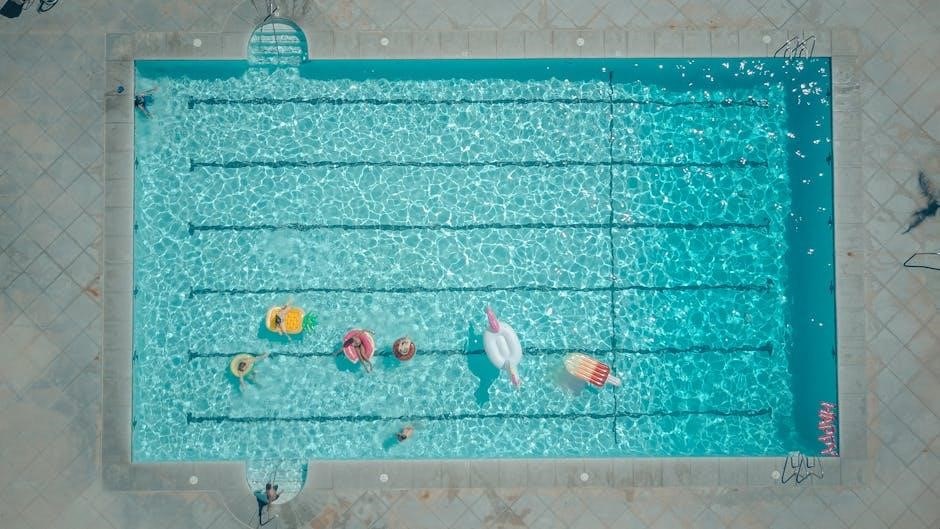
Additional Resources
Explore detailed guides, manufacturer instructions, and professional support to enhance your pool maintenance knowledge and ensure optimal care for your swimming pool throughout the year.
9.1 Recommended Maintenance Guides
Downloadable swimming pool maintenance guide PDFs offer comprehensive insights into pool care. These guides provide detailed tips, schedules, and best practices for maintaining clean and safe water. They cover topics like chemical balance, equipment care, and troubleshooting common issues. Many guides are tailored to specific pool types, such as residential or public pools. Whether you’re a new pool owner or experienced, these resources are invaluable for ensuring proper upkeep and enjoyment of your swimming pool year-round.
9.2 Manufacturer Instructions
Manufacturer instructions are essential for understanding specific maintenance requirements for your pool equipment. These guides, often included in swimming pool maintenance guide PDFs, provide detailed recommendations for pumps, filters, heaters, and automation systems. They outline maintenance schedules, chemical dosage guidelines, and troubleshooting tips tailored to your equipment. Adhering to these instructions ensures optimal performance, safety, and longevity of your pool components. Always refer to your manufacturer’s manual for model-specific advice to avoid voiding warranties or causing equipment damage.
9.3 Professional Assistance

For complex or time-consuming tasks, seeking professional assistance is highly recommended. Pool technicians can handle advanced maintenance, repairs, and chemical balancing, ensuring your pool remains safe and functional. They offer expertise in diagnosing issues like equipment malfunctions or persistent algae growth. Hiring a professional saves time and prevents potential damage from improper techniques. Many pool service companies provide regular maintenance packages tailored to your needs, offering peace of mind and optimal pool conditions year-round.